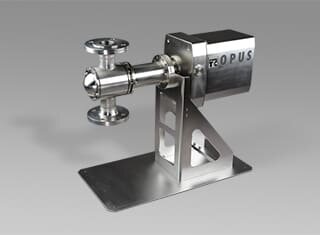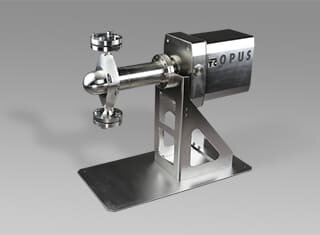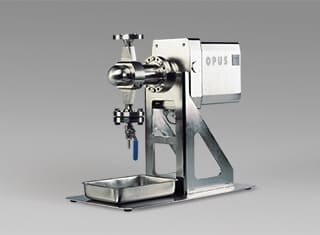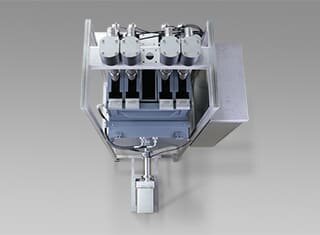Real-time particle size measurement from below 0.1 µm to 3,000 µm in suspensions and emulsions with ultrasonic extinction in process lines or vessels
The robust ultrasonic extinction sensor OPUS is integrated via an adapter flange (AF) directly in process lines or reactor vessel and monitors the changes in particle size distribution in continuous real-time analysis and the concentration of suspensions and emulsions in a range of below 0.1 µm to 3,000 µm. The acoustic measurement method offers outstanding capabilities for in-situ measuring, even in highly concentrated media. Using sound waves means that analyses can be performed in their original state regardless of the transparency of the material system – without dilution and under process conditions. The continuous recording of measurement values enables optimised process and quality control in crystallisation, polymerisation and particle synthesis.
The ultrasonic extinction allows for an extremely robust instrument design with a finger probe that withstands a temperature range of -20°C to 120°C, high pressures up to PN40, aggressive media and abrasive product streams. All components coming into contact with the product are adapted to the respective conditions and are designed in resistant materials: Finger, measurement zone and stainless steel housing (type 1.4571 | type 1.4539 optional) or highly corrosion-resistant nickel-chromium-molybdenum alloy (Hastelloy® C-22, type 2.4602), acoustic windows made of vitreous carbon (Sigradur®) and seals made of PTFE (Teflon™) or FFKM (Kalrez®). When required, sensor cooling with compressed air is available for continuous operation at high process and ambient temperatures. Safe operation in hazardous areas (ATEX) is ensured through an optional pressurised enclosure. Unlike the optical measuring method, the acoustic OPUS sensor is largely insensitive to fouling and product residue on the surfaces. In order to support continuous operation in media that tend to promote fouling, simple flushing nozzles can be used.
The OPUS system can be flexibly incorporated in a control system using common communication standards such as Modbus® RTU, Modbus® TCP, Profibus®, OPC (Open Platform Communications ), TCP/IP, FTP or analogue PLC signals in order to set up the remote-controlled or autonomous operation of measurements. The information gained in real-time about the particle size distribution and the concentration are provided to the process control system for process monitoring or for process control.
The ultrasonic measuring finger, with a diameter of 89 mm and a standard length of 336 mm for installation, is designed for installation in pipes with diameters from 200 mm or smaller reactor containers. The probe is fitted with a DN100 standard flange and is immersed in the product stream or the reactor medium. As an alternative to the DN100 flange, already present flange connectors can be used with DN150 and DN200. Applications in process lines with flow volumes of approximately 10 l/h to well over 10,000 l/h and reactor vessels with volumes of around 20 l to over 100,000 l form the usual spectrum. Depending on the product to be measured, the measurement gap on the tip of the measuring finger is opened between 1 mm and 10 mm, and records an analysis volume of up to 1,000 l/h depending on the flow rate.
Measuring finger lengths of up to 3,500 mm are available for using the probe in large reactor vessels – e.g. for installation through the reactor lid. In connection with a positioning and cleaning unit (Docking Positioner & Cleaner), the measuring zone is immersed in the suspension or emulsion in the vesslesfor measuring and, if required, is taken out for cleaning or maintenance without the process being interrupted.
The OPUS probe is used as an underwater probe for controlling the sediments carried in the streams. In this application, the sensor is in a waterproof housing and is positioned in the water at the desired depth. Only the measuring finger protrudes from the housing and continuously records the sediment stream flowing through the measuring gap.
Individual, customer-specific adaptation to the existing process environment and to the products that are to be measured takes place in close cooperation with the customer's process engineers and is accompanied by our experienced engineering team. Special equipment for potentially explosive areas (ATEX) is, of course, also part of our portfolio. We are also happy to provide alternative flange connections, pressure levels and special lengths upon request.
- Particle size, particle size distribution and concentration
- For suspensions and emulsions with particle concentrations up to 40 volume percent
- Product temperatures from -20°C to 120°C | pH values from 1 to 14 | Pressure level PN40
- For continuous real-time analyses in the process | in-line
- Highly resolved measuring range from < 0.1 µm to 3,000 µm | 31 measuring points
- For the installation in reactor containers from 20 l and in pipelines from DN200 with a flange adapter
- In-situ measurement under process conditions | No product removal or sample preparation
- Connection to process control systems | Modbus®, Profibus®, OPC, TCP/IP, SPS signals
- ATEX optional




















